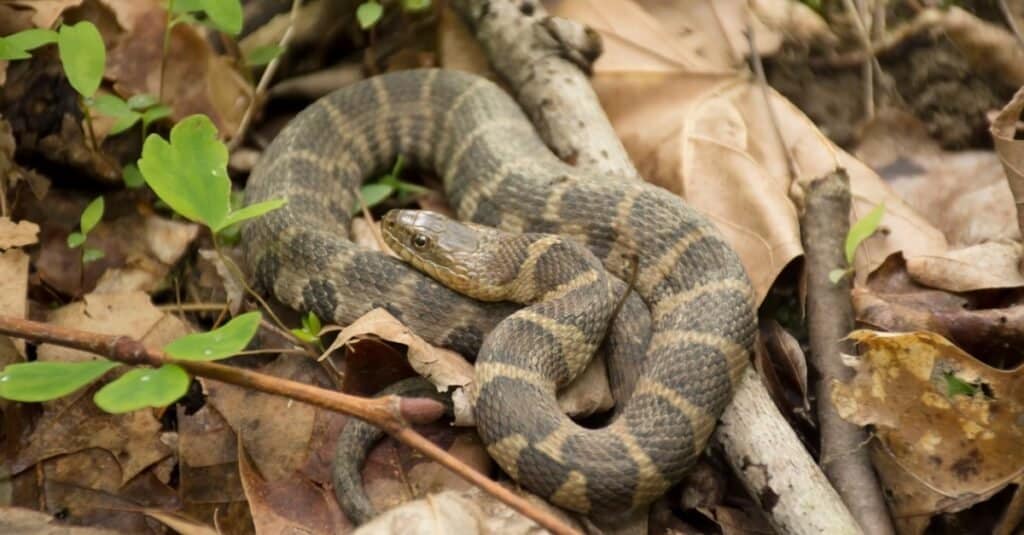Massachusetts is a small but diverse state in the New England region of the US. It has several distinct regions, including forests, mountains, a coastal plain, and numerous bays and rivers. In fact, approximately 25% of its entire area consists of water. Therefore, it’s not surprising that it is home to several water snakes. Although Massachusetts only has 14 different snakes, three of them inhabit areas in and around the water. So, let’s identify the water snakes in Massachusetts and find out what they look like, where they live, and what they eat.

1. Eastern Ribbon Snake (Thamnophis sauritus)

Amphibians make up approximately 90% of the eastern ribbon snake’s diet.
©Jay Ondreicka/Shutterstock.com
The first of the three snakes on our list is the eastern ribbon snake which is typically 18 to 36 inches long. They are slender snakes with long tail which is almost half of their body length. Eastern ribbon snakes have dark brown to black bodies which feature three greenish-yellow stripes. They have one down the center of their back and one down each side which is located on the third and fourth row of scales. They also have an unmarked white belly.
Eastern ribbon snakes occur statewide in Massachusetts and typically live close to a permanent source of water. They prefer areas with plenty of thick aquatic vegetation, such as the edges of rivers, ponds, and streams. Eastern ribbon snakes are excellent swimmers and often flee into the water if they are disturbed. Approximately 90% of their diet consists of amphibians, followed by fish, and finally insects and worms. They are not venomous and they swallow their prey alive.
Eastern ribbon snakes are ovoviviparous which means that the females produce eggs that remain inside their body until they hatch. Mating occurs in the spring and the young are born in the fall. Litters can consist of anything between six and 24 snakes. The young are between seven and nine inches long when they are born and have a similar color and pattern to adults.
2. Common Garter Snake (Thamnophis sirtalis)

Although their appearance can vary, many common garter snakes have dark bodies with three lighter-colored stripes.
©iStock.com/rkhalil
One of the most common water snakes in Massachusetts is the common garter snake which occurs statewide. Despite not being true water snakes, these snakes frequently inhabit areas close to water — typically around streams, ponds, and swamps. They also regularly prey on animals in and around the water, such as frogs, toads, salamanders, and fish. However, they do also prey on some small mammals, birds, and lizards. Common garter snakes contain a mild type of venom in their saliva. Despite this, they are not harmful to humans and any bite from them usually produces nothing more than a mild itching and burning sensation.
Common garter snakes can be anything from 22 to 40 inches long. Although their appearance can vary, they are commonly black or brown with three orange or yellow stripes along their back and sides. The area between the stripes can sometimes have either red or black spots. They also have an unmarked belly which can be either yellow, cream, or pale green.
Common garter snakes typically mate in the spring and the young snakes are born in July and August. They are ovoviviparous like the eastern ribbon snake. Juvenile common garter snakes are only five to nine inches long and the litter can consist of as many as 40 individuals.
3. Northern Water Snake (Nerodia sipedon)

The northern water snake has a brown body with dark crossbands and blotches.
©iStock.com/IcemanJ
The final water snake in Massachusetts is the northern water snake. Northern water snakes are the only true water snake in the state — being of the Nerodia genus. They are powerful snakes that often reach five feet long. Northern water snakes are typically brown or brownish-black with a series of darker markings. They initially have crossbands that begin at their neck but become blotches as they approach the tail. The markings are also usually wider on their back than they are on their sides. Although the venomous cottonmouth snake does not inhabit the state, northern water snakes are often mistaken for them in places where they do share the same range.
Northern water snakes live statewide in Massachusetts and inhabit virtually all wetland areas — including swamps, rivers, streams, salt marshes, and ditches. They rarely venture far from the water but can be observed basking in the sun on nearby rocks or hanging from branches. They are quick to flee back into the water at the first sign of a threat, but if they are cornered then they can be aggressive and will readily strike. Although they are not venomous snakes, they can inflict nasty wounds on their teeth. Their saliva contains an anti-coagulant that prevents blood from clotting properly, so wounds caused by them tend to bleed a lot.
Northern water snakes are typically diurnal and are active from early spring until October when they will brumate in crevices or burrows near to the water. They mate between May and June and the females give birth from August to October. Again, they are ovoviviparous so the female carries the eggs inside her until they hatch, then gives birth to live young.
The photo featured at the top of this post is © Steve Bower/Shutterstock.com
Discover the "Monster" Snake 5X Bigger than an Anaconda
Every day A-Z Animals sends out some of the most incredible facts in the world from our free newsletter. Want to discover the 10 most beautiful snakes in the world, a "snake island" where you're never more than 3 feet from danger, or a "monster" snake 5X larger than an anaconda? Then sign up right now and you'll start receiving our daily newsletter absolutely free.
Thank you for reading! Have some feedback for us? Contact the AZ Animals editorial team.







